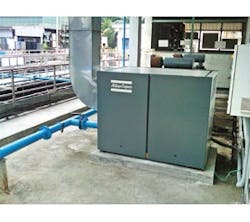Sandoz Pvt. Ltd. has achieved an average of 17% energy efficiency and lower noise levels by choosing Atlas Copco screw blower technology for its effluent treatment plant at its Navi Mumbai, India, factory.
Sandoz has established targets for reducing its carbon footprint by using resources more efficiently. It has planned a reduction of 1.5% of total site consumption every year. Selecting an Atlas Copco screw blower contributed to achieving the energy efficiency goal.
Sandoz works in the research and development of products to protect and improve health and well-being. The company has core businesses in generic pharmaceuticals. Product quality and safety are of paramount importance in the pharmaceutical industry, as it concerns the well-being of patients.
Shifting to Screw Blowers
The aeration process in the Sandoz effluent treatment plant was being managed by conventional lobe blowers. After experiencing reliability problems, it decided to shift to the new technology of screw blowers. An Atlas Copco ZS screw technology blower with variable-speed drive presented an opportunity not only to guarantee reliable performance, but also save on energy use.
The low-pressure screw blower was an ideal replacement for the conventional lobe blower, which consumed more energy and had high noise levels. A ZS 18 variable-speed drive blower was installed in July 2013, and Sandoz noticed results within a few months.
Minimizing Environmental Impact
Like Sandoz, there are many industries that use air blowers for their processes, especially those that operate wastewater treatment plants where aeration air blowers typically represent up to 70% of total electricity costs. In the treatment process, millions of bacteria feed on organic waste, breaking it up into carbon dioxide, nitrogen gas and water; because the bacteria need oxygen, a large quantity of air needs to be blown into the aeration tanks. These are the typical applications that can benefit from the energy efficiency of rotary screw air blowers.
“Our structured approach to minimize our environmental impact has helped us make considerable progress,” said Nitin Chaudhari, assistant manager of engineering with Sandoz. “Our waste management strategy is to prevent, reduce and recycle waste before treatment, incineration or disposal. The effluent treatment plant is critical for us to ensure that we walk our talk. Atlas Copco’s low-pressure screw blowers have helped us take an important step toward reducing energy cost and keeping the plant operating efficiently.”
Download: Here


